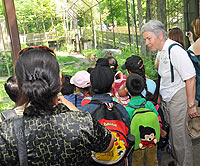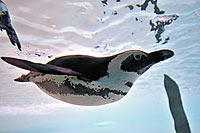©
Elementary Onsite School Program
EdVentures
Join our knowledgeable Zoo educators for a 75 minute, curriculum-linked, STEM learning experience. Programs begin either onsite with a Zoo tour or in a classroom setting. During a 30 minute interactive presentation, students participate in small group activities, designed to enhance and extend their learning. After touring through one of our pavilions and engaging with our staff, students will demonstrate an increased awareness and appreciation of wildlife and nature, and understand what steps they can take to help protect it.
Grade Level: |
K to 6 |
Price: |
$125 per session + $10.50 admission per student. 1 teacher per class receives FREE admission. Kindergarten: 1 teacher + 1 ECE per class receives FREE admission. Additional supervisors $10.50. 1:1 Support staff are free. |
Ratios: |
Grade K-3, 1 supervisor per 5 students. Grade 4-8, 1 supervisor per 10 students. |
Time: |
75 minutes (10:30am and 12:15pm sessions) |
Format: |
Interactive presentation with small group activities and tour through a pavilion enhanced with biofacts, interpretives, and discussions. |
Location: |
On-site and in a classroom setting |
Capacity: |
Maximum of 30 students per session. If you have additional students, we recommend booking a second program. Four programs may be booked simultaneously per session time. |
Notes: |
This is a Zoo Staff-led curriculum-linked program. Please book early, as programs fill up quickly. |

"It more than met my expectations. The leaders were absolutely fabulous - so informative!"
- Pickering Christian School

Topics
EXPAND ALL
 Kindergarten: Uniquely Me, ABC, 123
Kindergarten: Uniquely Me, ABC, 123- Students will be reminded through a read-aloud that all people have unique features that make them special. Through activities that focus on identifying unique animal attributes, they will create an animal handprint and playdoh model. Students will appreciate that animals are unique and so are they!
On a tour through the Indomalaya Pavilion, staff will encourage students to identify unique features of animals, spot patterns, count creature features like scutes on turtles, and challenge young learners to state what letter each animal begins with.  Grade 1: Needs, Senses, & Characteristics of Living Things
Grade 1: Needs, Senses, & Characteristics of Living Things- Back to basics including what is an environment, living vs non-living things, and the essential needs of living things in their environment. Students will be challenged to classify animals based upon physical characteristics that helps them survive. We put theory into practice as we tour the Americas Pavilion, using our senses to observe living things and discover a few animal senses that differ from our own!
 Grade 2: Classification and Adaptations of Living Things
Grade 2: Classification and Adaptations of Living Things- Students will love playing the role of Zoo Veterinarian as they determine the different physical characteristics between vertebrate & invertebrate animals by studying x-rays, classifying images, and examining insect biofacts during this interactive presentation. While on tour in the Australasia Pavilion, we discover “creature features'' or adaptations animals use to survive, and what we can do to help protect our environment.
 Grade 3: Plant and Animal Interactions
Grade 3: Plant and Animal Interactions- Students will be bloomin’ with excitement to learn all about plants! Focusing on basic needs, plant parts, and unearthing the mystery of seed dispersal, we examine different types of seeds before putting our knowledge to the test. The learning continues to grow while touring the Americas Pavilion as we discover how plants and animals (including humans) depend on each other for survival!
 Grade 4: Habitats, Communities, & Human Influences
Grade 4: Habitats, Communities, & Human Influences- Staff will review what a habitat is and guide students in a small group activity to identify different types of consumers by examining skull dentition. During the food chain challenge, students will be able to apply what they have learned by demonstrating the flow of energy through a habitat community. As we venture on a tour through the Indo-Malaya Pavilion, the positive and negative impacts people have on habitats and communities will be discussed.
 Grade 5: Animal Digestion, Health, & Well-being
Grade 5: Animal Digestion, Health, & Well-being- Hungry to extend your learning about animal digestive systems? By solving puzzles comparing the herbivore and carnivore digestive systems, students will be able to piece together and discover new knowledge for themselves. During your tour through the Indo-Malaya Pavilion, staff will discuss the important role that nutrition, enrichment, and technology has played in our animal’s “health & well-being” at the Zoo.
 Grade 6: Biodiversity & Human Impacts
Grade 6: Biodiversity & Human Impacts- There’s no doubt about it, biodiversity is essential to all living things. Students will gain a deeper understanding of the meaning of biodiversity by exploring its importance at the genetic, species, and ecosystem levels, starting off with a game where their traits determine their survival. Your guided exploration through the African Rainforest Pavilion will help students to appreciate how much humans rely on biodiversity, and the positive and negative ways that we impact it.












